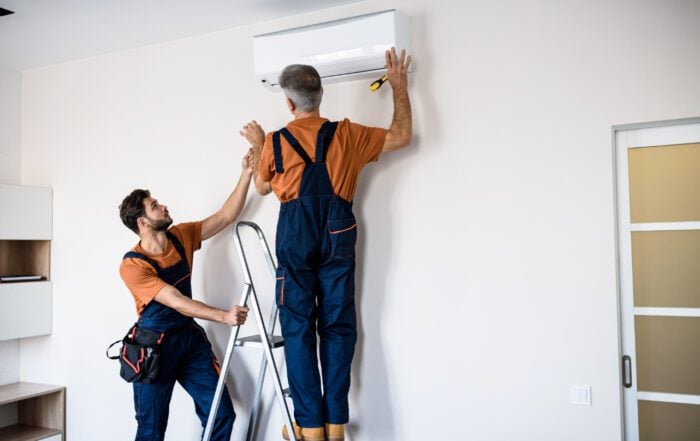As a homeowner, your home is your priority. You want to take care of it, so it serves you and your family for years to come. You remodel, fix things when you can, and hire professionals when you can’t. And you try to stay on top of information for when problems arise including plumbing, heating and cooling, and electrical. To make it as easy as possible for you, we’ve compiled a list of frequently asked electrical questions and answered them for you.
Question: What is a “short circuit?”
Answer: A short circuit (often called a “short”) occurs when the wire carrying the electrical current (referred to as the “hot wire” and usually black in color) has contact with the grounded conductor (the “neutral,” usually white in color) or the equipment ground (the “bare copper,” usually green).
When a short happens, it generates an overabundance of heat. If it’s left unchecked, it can create sparks resulting in an electrical fire. In the event of a short, your electrical panel will cut the power to the circuit.
Question: What’s a GFCI outlet?
Answer: GFCI stands for Ground Fault Circuit Interrupter. These outlets look slightly different than other outlets; there are two small buttons (“Test” and “Reset”) on the face where standard outlets have none. You may notice them on/in your home if it was built in 1981 or later, and you will typically find them in kitchens, bathrooms, garages, and on the outside of the house – all areas where water may be present.
A GFCI outlet’s purpose is to save you from electrical shock due to moisture. When the circuit trips, the “Reset” button should pop out. If the outlet doesn’t reset after you press the button, there may be an issue, and you should consult a professional like Stack.
Question: Are a fuse and a circuit breaker different?
Answer: They perform the same function but in different ways. Both fuses and breakers end the flow of electricity to prevent a problem. Circuit breakers can be reset each time you trip them, but fuses must be replaced. For this specific reason, circuit breakers are more often used, but you can still find fuse boxes in many old Cleveland homes.
Question: My refrigerator isn’t working. I checked the circuit breaker, but it wasn’t tripped. What’s the problem?
Answer: If you have an older home (1981 or prior), chances are you actually have two circuits for your kitchen which give power to your appliances. If one hasn’t tripped, the other most likely has. But if you’ve checked both of them, there may be a wiring issue, and you should contact your electrician.
If your home was built after 1981, it’s more likely that one of the GFCI outlets has tripped. You’ll want to scan your outlets for any “Reset” button that’s no longer depressed. If you don’t hear a click after you press it back into place and there’s still no power, there may be an issue with the circuit which a qualified electrician will need to assess.
Question: When I use my microwave, the lights dim, and sometimes the breaker trips. Why?
Answer: If this is happening, you probably have your microwave mounted under your cabinets, above your stove. These draw around 1100-1800 watts depending on the model and features and are added after the home was built. During the building process, a range hood is the only thing installed there which requires a lower draw of energy, so a circuit with a lower watt capacity is designated for that area (usually a 15 amp circuit which has a maximum allowable load of 1480 watts). That means the breaker will trip once it passes about 1800 watts.
If you have a mounted microwave, you’re already beginning to max out the circuit. When you have the room lights on as well, you’re getting close to tripping the circuit breaker which is why your lights are dimming.
To fix this issue, try adding a new 20 amp, 120-volt circuit specifically for your microwave. This will meet current safety codes and give your microwave sufficient power without tripping the breaker.
Question: Is it normal for my lights to dim occasionally and then return to normal?
Answer: Yes and no. You could be experiencing what’s known as a “brown out.” These usually happen during the summer thanks to air conditioners continually running to keep our homes and workplaces comfortable. All the extra energy consumption puts stress on the power grids, and that, in turn, causes less electricity to be available for your home. Ergo, your lights dim for no seeable reason.
Or it could also be a loose neutral (see the first question) connection to the main power line or your electrical panel. You’ll want to call your power company first; if they don’t see an issue on their end, contact your electrician.
Question: I replaced my fluorescent bulbs. Why are they still flickering?
Answer: Your issue could be due to a number of things:
- Are all the prongs lined up? Fluorescent bulbs have two prongs at each end. If there is one that doesn’t line up correctly, the bulb will fail to light properly.
- Are you sure you replaced all the bulbs? Some fixures will not turn on or may flicker if you only replace one light.
- Is your ballast burned out? That’s the black box inside the fixture which is basically a transformer that converts the 120-volt supply to whatever the fluorescent lights need. If this has burned out, it could be the source of your lack of proper lighting.
Question: When I run my portable generator during a power outage, why does it barely power my lights and 240-volt appliances?
Answer: There may be a switch you need to toggle. Some of the higher quality portable generators have a switch to let you change between 120-volt and 240-volt settings. It’s possible that you have it set to 120-volt instead of the 240-volt setting.
Question: I’ve noticed a dimmer that feels warm. Is this normal?
Answer: Generally, yes. A dimmer is just a small-scale transformer that increases or decreases the voltage to the lights. As it lowers the voltage, heat is generated and can make the dimmer plate warm. There’s no reason for concern unless you start smelling burning plastic, you begin to hear buzzing, or the lights start to flicker.
Question: Why doesn’t a specific outlet work?
Answer: Is it an outlet that’s controlled by a switch? This may seem obvious, but if you’ve recently moved, something like a wall switch can be easily overlooked. Try plugging something into it like a floor lamp and start toggling the wall switches in the room. If this doesn’t give you a solution, check to see if other outlets are out as well. This could be a sign that you have a tripped circuit and the breaker just needs to be reset. If resetting the breaker doesn’t work either, contact a qualified, licensed electrician to assess the outlet.
Question: How do I know if my electrical panel is unsafe?
Answer: If your electrical panel is out of date, it’s probably not meeting your home’s needs. As we continue to add more and more electronics and appliances, we demand more from our panel, and older ones are not up to the task. If your panel is 25-years old, or if you’re noticing frequent shorts or dimming lights, it’s time for an upgrade.
If you have a question that wasn’t answered here, feel free to give us a call or schedule a home visit. As industry experts since 1976, we’ll have the answers you’re looking for.
Have Any Questions?
If this is an emergency please call 440-937-9134.
Otherwise, please feel free to call us or submit this form to schedule an appointment for service or request an estimate. We will contact you shortly!



